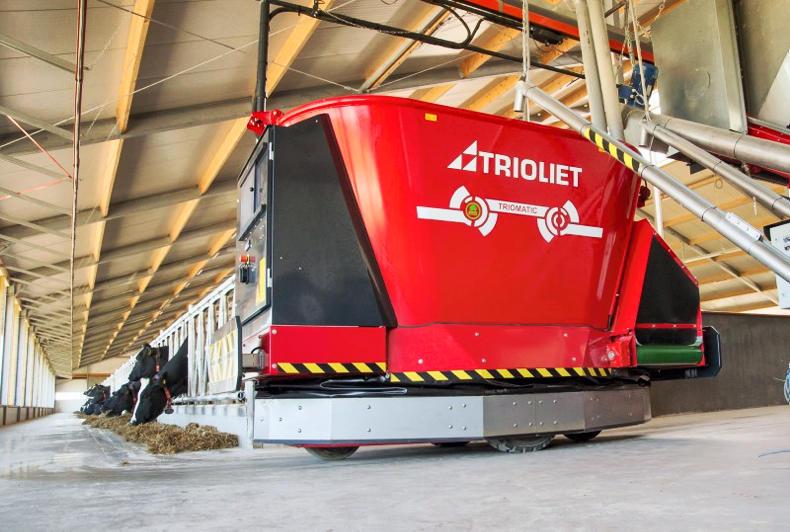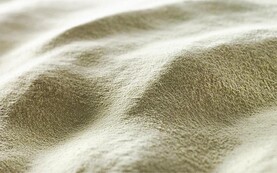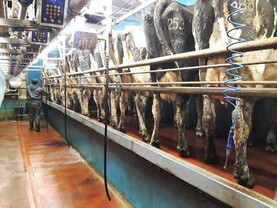Farming is evolving like every industry in the world. Change happens, and this may have many benefits in the years to follow. So just how advanced has the job of putting feed in front of animals become?
There are a number of manufacturers producing fully automated robotic feed systems. Lely seems to be the company that is making the biggest impact on Irish farms to date. Its robotic milking machine was one of the first automated milking systems to make a debut on Irish dairy farms. But other manufacturers have also entered the market. Some of the other known robotic feeder manufacturers on the market are Lucas and Trioliet.
Robotic feeding is currently functional on just a small number of farms in Ireland. According to Lely Ireland, the interest is growing, and the company expects further sales of the Lely Vector feeding system with numerous advantages to be achieved from robotic feeding – offering greater flexibility to farmers, cutting costs on feed, in turn giving farmers a better insight into their returns.
We decided to take a look into some of the other robotic feeding systems available today.

Lely Vector both feeding and pushing silage.
Lely offers a full range of robotic equipment to aid farmers, with the aim of reducing labour and increasing productivity on farms.
The company, established in the Netherlands in 1948, has had a version of its robotic diet feeder on the market since 2012 and released the new and improved Vector on 6 September this year. The Vector now offers a stainless steel mixing bin and auger, a galvanised bumper, a mounted magnet to collect foreign metal objects, cleverly distributed knives and constant auger speed, meaning a more consistently mixed ration. It has a holding capacity of 2m3 with the capability of feeding up to 350 cows. As with most robotic feeders, a feed kitchen is required.
This is where the Vector returns to when empty. The feed kitchen has set locations for different feed types so that it knows what feed is kept where.
The kitchen has to be stocked with feed and concentrates, with size and cow numbers determining how frequently. A gantry-style grab loads the vector, all controlled via smartphone.
Lely offers a service to help farmers from start to finish when it comes to kitchen design, feeder routing and installations etc.
Trioliet Triomatic WP 2 300 wheeled feeding robot
Trioliet has had robotic feed systems on the market since 2005. The company – founded by brothers Max, Fred and Cees (trio) Liet in 1950 – now offers both a feeder that suspends from the roof of a shed along with a wheeled variant introduced in 2016. This automatic feeding robot drives on four wheels. Two of the wheels have differential steering (skid steering), enabling the robot to manoeuvre easily in the feeding passage. The robot has a mixing tub with 3m3 capacity and two vertical augers which is claimed to have the ability to feed up to 700 cows. Operation is controlled by a 15in touchscreen. The power supply runs on a power rail. An integrated silage pusher is optional. The ability to feed both directions via conveyor belt comes as standard. The Triomatic doesn’t offer a dedicated gantry-style kitchen. It has its own separate Triomatic T40 Feed kitchen.
Lucas I-Ron Mix
System Feed Robot

Lucas I-Ron Feeder in action.
The feed robot offered by Lucas is only capable of distributing the ration. The mixes are made up beforehand by a stationary diet feeder that ensures an even mixture. So really, the 2.5m3 capacity I-Ron is only a distribution method, with the capability to feed 350 cows.
This type of system leaves us wondering is it worth the additional infrastructure as the feed kitchen requires a large amount of space due to the fact a stationary diet feeder needs to be filled by another automated system, and then loaded into the distribution robot. This process is more complicated than the simpler setup of the Lely Vector.

Schuitemaker's Innovado loading via intake auger.
Dutch manufacturer Schuitemaker has an automated feeding system operating in both Germany and the Netherlands, following 10 years of development. The company has attempted to produce what other brands have failed to do – an individual standalone unit that will load its 8m3 body at the clamp, add concentrates, then mix and dispense. This eliminates the need for a feed kitchen, meaning more available space within the shed and reduced overall capital expenditure. The Schuitmaker’s Innovado is somewhat like a self-driving self-propelled feeder.
Loading is by way of a cutting arm and conveyor. However, rather than a milling head which the manufacturer claim mulches material damaging feed structure, the cutting bar takes vertical slices from the clamp face similar to that of a shear grab. It has the ability to take on board products such as brewers’ grain and other bulk concentrates using an intake auger. Cleaning of the clamp can also be done with the auger.
When used in a feed passage, the Innovado features two hydraulically folding feed pushers which can be used between feeding times to keep feed pushed up against the barrier. At the heart of this impressive wagon is a 75hp engine. Schuitemakers claim the Innovado has capabilities of feeding upwards of 700 cows and 250 heifers.
Navigation of the Innovado is fully autonomous, with the path of the machine indoors guided by transponders buried in the ground. Outside of buildings, around the yard, guidance is taken care of via real-time kinetics (RTK). Various routes can be programmed and altered to suit user requirements.
All rations and feeding times are planned via a central feed management programme.
Farming is evolving like every industry in the world. Change happens, and this may have many benefits in the years to follow. So just how advanced has the job of putting feed in front of animals become?
There are a number of manufacturers producing fully automated robotic feed systems. Lely seems to be the company that is making the biggest impact on Irish farms to date. Its robotic milking machine was one of the first automated milking systems to make a debut on Irish dairy farms. But other manufacturers have also entered the market. Some of the other known robotic feeder manufacturers on the market are Lucas and Trioliet.
Robotic feeding is currently functional on just a small number of farms in Ireland. According to Lely Ireland, the interest is growing, and the company expects further sales of the Lely Vector feeding system with numerous advantages to be achieved from robotic feeding – offering greater flexibility to farmers, cutting costs on feed, in turn giving farmers a better insight into their returns.
We decided to take a look into some of the other robotic feeding systems available today.

Lely Vector both feeding and pushing silage.
Lely offers a full range of robotic equipment to aid farmers, with the aim of reducing labour and increasing productivity on farms.
The company, established in the Netherlands in 1948, has had a version of its robotic diet feeder on the market since 2012 and released the new and improved Vector on 6 September this year. The Vector now offers a stainless steel mixing bin and auger, a galvanised bumper, a mounted magnet to collect foreign metal objects, cleverly distributed knives and constant auger speed, meaning a more consistently mixed ration. It has a holding capacity of 2m3 with the capability of feeding up to 350 cows. As with most robotic feeders, a feed kitchen is required.
This is where the Vector returns to when empty. The feed kitchen has set locations for different feed types so that it knows what feed is kept where.
The kitchen has to be stocked with feed and concentrates, with size and cow numbers determining how frequently. A gantry-style grab loads the vector, all controlled via smartphone.
Lely offers a service to help farmers from start to finish when it comes to kitchen design, feeder routing and installations etc.
Trioliet Triomatic WP 2 300 wheeled feeding robot
Trioliet has had robotic feed systems on the market since 2005. The company – founded by brothers Max, Fred and Cees (trio) Liet in 1950 – now offers both a feeder that suspends from the roof of a shed along with a wheeled variant introduced in 2016. This automatic feeding robot drives on four wheels. Two of the wheels have differential steering (skid steering), enabling the robot to manoeuvre easily in the feeding passage. The robot has a mixing tub with 3m3 capacity and two vertical augers which is claimed to have the ability to feed up to 700 cows. Operation is controlled by a 15in touchscreen. The power supply runs on a power rail. An integrated silage pusher is optional. The ability to feed both directions via conveyor belt comes as standard. The Triomatic doesn’t offer a dedicated gantry-style kitchen. It has its own separate Triomatic T40 Feed kitchen.
Lucas I-Ron Mix
System Feed Robot

Lucas I-Ron Feeder in action.
The feed robot offered by Lucas is only capable of distributing the ration. The mixes are made up beforehand by a stationary diet feeder that ensures an even mixture. So really, the 2.5m3 capacity I-Ron is only a distribution method, with the capability to feed 350 cows.
This type of system leaves us wondering is it worth the additional infrastructure as the feed kitchen requires a large amount of space due to the fact a stationary diet feeder needs to be filled by another automated system, and then loaded into the distribution robot. This process is more complicated than the simpler setup of the Lely Vector.

Schuitemaker's Innovado loading via intake auger.
Dutch manufacturer Schuitemaker has an automated feeding system operating in both Germany and the Netherlands, following 10 years of development. The company has attempted to produce what other brands have failed to do – an individual standalone unit that will load its 8m3 body at the clamp, add concentrates, then mix and dispense. This eliminates the need for a feed kitchen, meaning more available space within the shed and reduced overall capital expenditure. The Schuitmaker’s Innovado is somewhat like a self-driving self-propelled feeder.
Loading is by way of a cutting arm and conveyor. However, rather than a milling head which the manufacturer claim mulches material damaging feed structure, the cutting bar takes vertical slices from the clamp face similar to that of a shear grab. It has the ability to take on board products such as brewers’ grain and other bulk concentrates using an intake auger. Cleaning of the clamp can also be done with the auger.
When used in a feed passage, the Innovado features two hydraulically folding feed pushers which can be used between feeding times to keep feed pushed up against the barrier. At the heart of this impressive wagon is a 75hp engine. Schuitemakers claim the Innovado has capabilities of feeding upwards of 700 cows and 250 heifers.
Navigation of the Innovado is fully autonomous, with the path of the machine indoors guided by transponders buried in the ground. Outside of buildings, around the yard, guidance is taken care of via real-time kinetics (RTK). Various routes can be programmed and altered to suit user requirements.
All rations and feeding times are planned via a central feed management programme.









 This is a subscriber-only article
This is a subscriber-only article










SHARING OPTIONS: